In Part 1 of How to Practice Creatively, I spoke about blind repetition inducing a phenomenon in the brain called “masking,” whereby the brain doesn’t pay attention to a repeated, predictable event like a clock ticking or a whirring of a fan after it knows that event will continue as before. So the “cure” to masking is to have focused practice sessions.
This means that every time you sit down to play, you should have a specific task you are trying to accomplish with your time. The more specific the task, the more effective and creative your practice time will be – and the more interesting. So the first step to creative practice is to have a specific goal.
Every time you sit down to play, you should have a specific task you are trying to accomplish with your time.
Focused Practice Sessions
For example, in measure 5-6, you may have noticed from the last time you played this piece that you really have no idea what this passage is supposed to sound like. Every time you play it you struggle through it, but you really don’t “get it” no matter how many times you go through it. So perhaps one of your goals for that day’s practice is to figure out what’s up with m. 5-6. This could mean deciphering the rhythm through subdividing the beats and tapping and counting it out, or it could mean reading every note because you’re not quite sure of what notes to play, or maybe the accidentals are throwing you off.
Or, in the case you already know what’s wrong with m. 5-6 (like you just can’t get the LH and the RH to play at the same time correctly), then your goal might be something like working on coordinating both hands playing together there.
Other problems may entail figuring out how you want to musically express a passage. You perhaps play around with a few ideas when you practice, but you really need to nail down what works and what you’re trying to say. Some pieces are very straight-forward in what they’re expressing, but even great composers wrote stuff that is repetitive, uninteresting, or just an enigma as to what they were getting at. It’s our job to make it interesting and expressive and downplay the repetitive nature of the passage or piece (lest we get that masking thing going again!).
You’re probably starting to get the idea. The details on some of the many creative practice techniques you can specifically employ in these and other goals are detailed later in this series – so we will come back to how exactly you do this.
The main point is you need to start out listing which problem areas need fixing in this particular practice session. Always start with the biggest, most obvious problems. Sometimes you’ll have little nagging issues like a transition from one section to the next, or one note that you sometimes play wrong, but then there’s this huge passage that you’re having loads or trouble with executing properly even at a slow tempo. Pick on the big things first. As they get easier, then you may have some time to be able to look at the places that are lesser problems, but problems that need fixing nonetheless.
Play Only the Problems
Not all measures are created equal, so not all measures need to be played through every day. Don’t waste your time on the easy measures, but focus on the hardest measures first. Then every 2 or 3 days, you can play through the whole piece as close to tempo as possible to see how things are progressing. On these days, you’ll probably get some good news and bad news: the good news might be that a passage has gotten much easier, the bad news might be that it still needs more work, or that new problems have come to the forefront. Just make a mental (or written) note of those things, and get to tackling them tomorrow.
The list of things to do in a piece may be overwhelming, like each piece is your own personal Mount Everest to conquer (or be conquered by). Avoid making a HUGE list to do – it will only overwhelm you and make you feel like you didn’t make a dent in anything after you are only able to do 2-3 things that day. Only pick on a few things that you can accomplish that day, and focus on the largest problem areas first. Anything that you can’t get to that day, can always be done another day. Remember: this is a process.
Have a Game Plan
So the next time you sit down to practice, have a game plan. You may want to keep a piano journal, or just make a mental note as you leaf through the pages of the piece you are about to work on. Pinpoint the spot that at that moment you know is the biggest problem, and then figure out what is exactly wrong with it. Then come up with different ways you can work on that passage to help correct the problem. Work on that for a little bit, then move on to the next problem area. Only do 2-3 different areas in a piece per day, then move on to another piece and repeat the process.
It’s my understanding one doesn’t climb Mount Everest in a day, and so the same can be said for learning a piece of music. You do have to rest and recuperate in between practice sessions. That gives the mind time to let the work that you did “gel”. But if you go at practice in this focused manner, you will avoid the boring, repetitive practice sessions, and as a bonus you will actually make faster progress than if you played straight through a piece 3 times. And let’s face it: progress is exciting and makes you eager to come back the next day to get further.
Let me know how this idea of Focused Practice has helped your practice sessions – I’d love to hear comments on this idea and what methods you use to figure out what needs the most work. Next time, I’ll be talking about how Playing Expressively in your practice session can help you enjoy practicing – even if mistakes are there!



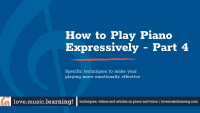
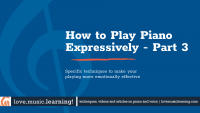
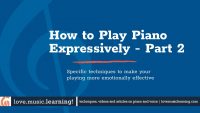
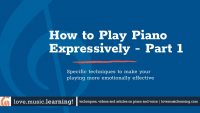
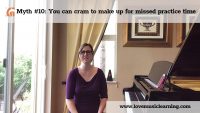

Excellent article. I follow your posts on the Piano World forum and appreciate your taking time to post on the Adult Beginners forum. Looking forward to future articles. Many thanks.
Thank you for reading and commenting – I appreciate the feedback. I am releasing new posts later this week! If there are any topics that you’d like to have me post on, feel free to offer suggestions.